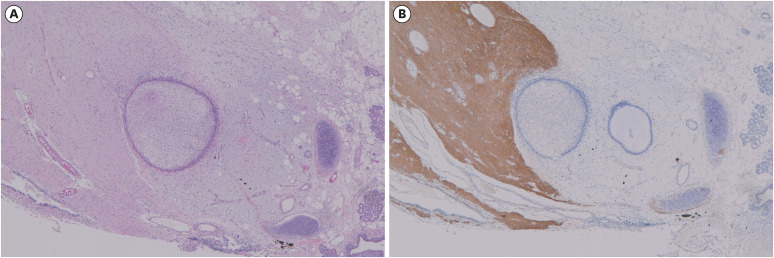J Korean Med Sci.
2020 Jun;35(24):e207. 10.3346/jkms.2020.35.e207.
Anti-N-methyl-D-aspartate Receptor Encephalitis: a Rare Complication of Ovarian Teratoma
- Affiliations
-
- 1Department of Obstetrics and Gynecology, Dongguk University College of Medicine, Seoul, Korea
- 2Department of Neurology, Dongguk University College of Medicine, Seoul, Korea
- 3Department of Pathology, Dongguk University College of Medicine, Seoul, Korea
- 4Department of Obstetrics and Gynecology, CHA Ilsan Medical Center, CHA University School of Medicine, Goyang, Korea
- KMID: 2503016
- DOI: http://doi.org/10.3346/jkms.2020.35.e207
Abstract
- Anti-N-methyl-D-aspartate receptor (anti-NMDAR) encephalitis is a potentially life-threatening but reversible autoimmune disorder characterized by psychiatric symptoms, cognitive dysfunction, speech dysfunction, seizures, movement disorder, decreased level of consciousness, and autonomic dysfunction or central hypoventilation. It occurs predominantly in young women and approximately half of them have underlying tumors, mainly ovarian teratoma. A 24-year old woman was admitted because of fever, headache, abnormal movement and decreased mental status. Five cycles of plasmapheresis improved her neurological and mental status. Anti-NMDAR antibodies in her CSF and serum were positive, and computed tomography revealed a 1-cm sized mass suggestive of mature cystic teratoma arising from the right ovary. We promptly performed laparoscopic right ovarian cystectomy. She was discharged after 2 weeks with mild memory deficit. Prompt removal of ovarian teratoma and multidisciplinary care are particularly important for good outcome.
Figure
Cited by 1 articles
-
Anti-
N -methyl-D-aspartate receptor encephalitis associated with ovarian teratoma in Korea: three case reports
Jisun Lee, Seongwoo Kang, Hye Jin Chang, Yong Hee Lee, Joo-Hyuk Son, Tae Wook Kong, Suk-Joon Chang, Kyung Joo Hwang, Miran Kim
Yeungnam Univ J Med. 2021;38(4):350-355. doi: 10.12701/yujm.2020.00794.
Reference
-
1. Park SB, Kim JK, Kim KR, Cho KS. Imaging findings of complications and unusual manifestations of ovarian teratomas. Radiographics. 2008; 28(4):969–983. PMID: 18635624.
Article2. Dalmau J, Tüzün E, Wu HY, Masjuan J, Rossi JE, Voloschin A, et al. Paraneoplastic anti-N-methyl-D-aspartate receptor encephalitis associated with ovarian teratoma. Ann Neurol. 2007; 61(1):25–36. PMID: 17262855.
Article3. Gleichman AJ, Spruce LA, Dalmau J, Seeholzer SH, Lynch DR. Anti-NMDA receptor encephalitis antibody binding is dependent on amino acid identity of a small region within the GluN1 amino terminal domain. J Neurosci. 2012; 32(32):11082–11094. PMID: 22875940.
Article4. Dalmau J, Gleichman AJ, Hughes EG, Rossi JE, Peng X, Lai M, et al. Anti-NMDA-receptor encephalitis: case series and analysis of the effects of antibodies. Lancet Neurol. 2008; 7(12):1091–1098. PMID: 18851928.
Article5. Titulaer MJ, McCracken L, Gabilondo I, Armangué T, Glaser C, Iizuka T, et al. Treatment and prognostic factors for long-term outcome in patients with anti-NMDA receptor encephalitis: an observational cohort study. Lancet Neurol. 2013; 12(2):157–165. PMID: 23290630.
Article6. Gable MS, Sheriff H, Dalmau J, Tilley DH, Glaser CA. The frequency of autoimmune N-methyl-D-aspartate receptor encephalitis surpasses that of individual viral etiologies in young individuals enrolled in the California encephalitis project. Clin Infect Dis. 2012; 54(7):899–904. PMID: 22281844.
Article7. Vitaliani R, Mason W, Ances B, Zwerdling T, Jiang Z, Dalmau J. Paraneoplastic encephalitis, psychiatric symptoms, and hypoventilation in ovarian teratoma. Ann Neurol. 2005; 58(4):594–604. PMID: 16178029.
Article8. Dalmau J, Lancaster E, Martinez-Hernandez E, Rosenfeld MR, Balice-Gordon R. Clinical experience and laboratory investigations in patients with anti-NMDAR encephalitis. Lancet Neurol. 2011; 10(1):63–74. PMID: 21163445.
Article9. Dalmau J, Graus F. Antibody-mediated encephalitis. N Engl J Med. 2018; 378(9):840–851. PMID: 29490181.
Article10. Bost C, Chanson E, Picard G, Meyronet D, Mayeur ME, Ducray F, et al. Malignant tumors in autoimmune encephalitis with anti-NMDA receptor antibodies. J Neurol. 2018; 265(10):2190–2200. PMID: 30003358.
Article11. Acién P, Acién M, Ruiz-Maciá E, Martín-Estefanía C. Ovarian teratoma-associated anti-NMDAR encephalitis: a systematic review of reported cases. Orphanet J Rare Dis. 2014; 9(1):157. PMID: 25312434.
Article12. Smith HO, Berwick M, Verschraegen CF, Wiggins C, Lansing L, Muller CY, et al. Incidence and survival rates for female malignant germ cell tumors. Obstet Gynecol. 2006; 107(5):1075–1085. PMID: 16648414.
Article13. Gresa-Arribas N, Titulaer MJ, Torrents A, Aguilar E, McCracken L, Leypoldt F, et al. Antibody titres at diagnosis and during follow-up of anti-NMDA receptor encephalitis: a retrospective study. Lancet Neurol. 2014; 13(2):167–177. PMID: 24360484.
Article
- Full Text Links
- Actions
-
Cited
- CITED
-
- Close
- Share
- Similar articles
-
- Ovarian teratoma associated anti-N-methyl-D-aspartate receptor encephalitis presenting abnormal behavior
- Anti-N-methyl-D-aspartate Receptor Encephalitis Caused by a Mature Mediastinal Teratoma
- Case of anti-N-methyl D-aspartate receptor encephalitis associated with ovarian teratoma presenting as suicidal ideation
- Anti-N-Methyl-D-Aspartate Receptor Encephalitis with Ovarian Teratoma Improved by Prompt Surgery
- Anti-NMDA Receptor Encephalitis Which Has Shown Clinical Symptoms of Schizophrenia


